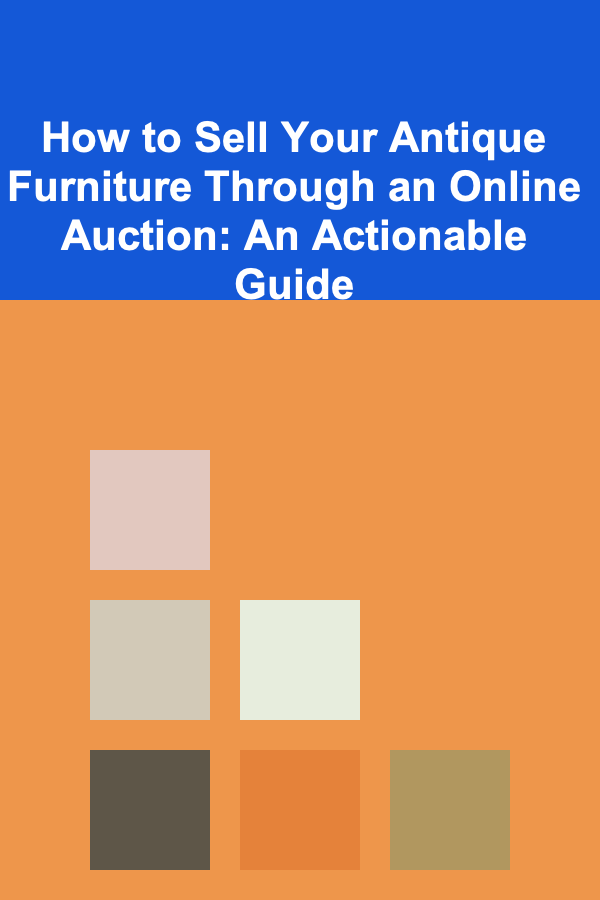
How to Sell Your Antique Furniture Through an Online Auction: An Actionable Guide
ebook include PDF & Audio bundle (Micro Guide)
$12.99$10.99
Limited Time Offer! Order within the next:

Selling antique furniture can be a rewarding experience. Not only can you make a profit from pieces that may have appreciated in value over time, but you also have the chance to connect with collectors or enthusiasts who share a passion for vintage furniture. One of the most effective ways to sell your antique furniture today is through an online auction. Online auction platforms offer global reach, ease of use, and an efficient way to sell your items in a competitive environment. However, to maximize your chances of success, there are several steps you need to take before listing your antique furniture at auction.
In this guide, we'll walk you through the key actions you need to take to successfully sell your antique furniture via an online auction.
Understand the Value of Your Antique Furniture
Before you list your antique furniture for sale, it's essential to understand its value. Unlike modern items, antique furniture can be highly variable in price, depending on factors like its age, condition, rarity, craftsmanship, provenance, and market demand. Doing thorough research can help you set a realistic price expectation and avoid underselling your item.
Steps to Determine Value:
- Research Similar Pieces: Start by searching for similar pieces of furniture on auction platforms like eBay, Bonhams, and Christie's. This will give you a rough idea of the price range for similar items.
- Consult an Expert: If you are unsure about the value, consider consulting an antiques appraiser or professional who specializes in vintage furniture. An expert can give you an accurate valuation and advise you on the best way to present your piece for sale.
- Check Auction Results: Review the results of past auctions where similar furniture items were sold. Auction houses often provide archives of past sales with final hammer prices. This data will help you gauge the potential selling price.
- Look at Condition: A piece's condition is one of the most important factors in determining its value. Inspect your furniture closely for any damage or restoration work, as these will affect its value.
Key Value Indicators:
- Age and Rarity: Older, rare pieces tend to fetch higher prices, especially if they come from recognized designers or historical periods.
- Material and Craftsmanship: High-quality materials, like walnut, mahogany, or oak, and exceptional craftsmanship can significantly increase a piece's value.
- Provenance: A history of ownership, especially by notable figures or institutions, can raise a piece's value.
Choose the Right Online Auction Platform
Once you've determined the value of your antique furniture, the next step is selecting the right auction platform. Not all online auction sites are the same, and choosing the wrong one could reduce your chances of selling your item at a good price. Here are some of the most popular online auction platforms for selling antique furniture:
Popular Auction Platforms:
- eBay: One of the largest and most accessible online auction platforms, eBay is ideal for individuals who want to reach a wide audience. The platform allows you to auction off a variety of items, including antique furniture.
- LiveAuctioneers: Specializing in high-end antiques and collectibles, LiveAuctioneers is a great option if you're selling high-value furniture pieces.
- Bonhams: Known for its luxury and fine art auctions, Bonhams provides a curated marketplace for antique furniture, particularly rare and high-end items.
- Sotheby's: For the truly rare and valuable pieces, Sotheby's auction house offers online bidding for some of the world's most exquisite antiques.
- Chairish: Specializing in vintage and antique furniture, Chairish offers a platform for selling curated, high-quality items.
Factors to Consider When Choosing a Platform:
- Audience: Make sure the platform has an audience that is specifically interested in antique furniture. Some auction houses cater to high-end collectors, while others may serve a broader audience.
- Fees: Each auction site charges fees for listing, selling, and sometimes shipping your item. Be sure to compare the fees across platforms and consider how they might impact your sale.
- Auction Format: Check if the platform allows for live auctions, timed auctions, or both. Live auctions may create more excitement and competition for your item.
- Reputation: Look for platforms with strong reputations and a history of successful antique furniture sales. Sites like Sotheby's and Bonhams are known for handling high-value antiques, while eBay has a broad audience.
Prepare Your Antique Furniture for Sale
Presentation is key when selling antique furniture. The more effort you put into preparing your item for the auction, the higher the chances that it will attract interest from potential buyers.
Steps to Prepare Your Antique Furniture:
-
Clean and Restore: Before photographing and listing your furniture, clean it thoroughly to ensure that it looks its best. For minor repairs or restorations, consider hiring a professional who specializes in antiques. However, avoid over-restoring, as buyers may prefer the item to retain its original patina.
-
Take High-Quality Photos: The photos of your furniture will be the first thing potential buyers see. High-quality images are crucial for generating interest and conveying the true value of the piece. Take multiple photos from different angles, and be sure to capture any unique features or markings.
- Lighting: Ensure the lighting is bright and even to show off the piece's details.
- Background: Use a neutral background to ensure that the furniture is the focus of the photograph.
- Close-ups: Include close-up shots of any distinguishing features, such as carving, hardware, or labels, to provide additional context and appeal.
-
Provide Detailed Descriptions: Your auction listing should include a comprehensive description of the furniture, including its dimensions, age, material, designer (if known), condition, and any notable features. Be transparent about any flaws, repairs, or restorations to avoid misunderstandings with buyers.
Set the Right Starting Price
One of the most important aspects of selling antique furniture through an online auction is setting the right starting price. An effective starting price can help generate interest and encourage bidding, while an unrealistic price can deter potential buyers.
Pricing Strategies:
- Start Low for Bidding Interest: If you want to encourage more bidders and create a competitive auction, start with a low opening bid. This strategy can help generate excitement and drive up the final price, especially if there's a lot of interest in the piece.
- Reserve Price: Many auction platforms allow you to set a reserve price, which is the minimum amount you're willing to accept for the item. If bidding doesn't reach the reserve price, the item won't be sold. This provides a safety net but can also discourage bidders if set too high.
- Consider Auction House Estimates: Some auction platforms, particularly high-end houses like Sotheby's or Bonhams, will provide estimates for your piece. These estimates can serve as a guide for setting your opening price and reserve price.
Market Your Antique Furniture Listing
Once your item is listed, it's time to generate buzz and attract potential buyers. Marketing your auction listing can significantly increase its visibility and improve your chances of making a successful sale.
Tips for Marketing Your Auction:
- Social Media: Share your auction listing on social media platforms such as Instagram, Facebook, and Pinterest. Use hashtags relevant to vintage furniture and antiques to increase visibility.
- Email Newsletters: If you have an email list, send a newsletter to your subscribers with a link to your auction listing. Highlight the unique features of the furniture and why it's a must-have piece.
- Collaborate with Influencers or Blogs: Consider reaching out to influencers, bloggers, or social media personalities who specialize in antique furniture. They can help promote your auction to a relevant and engaged audience.
Monitor Your Auction and Respond to Inquiries
Once your auction is live, keep an eye on it to ensure that everything is running smoothly. Many online auction platforms will allow you to monitor bids, answer questions from potential buyers, and provide additional information if necessary.
Best Practices:
- Answer Questions Promptly: Be proactive in responding to inquiries from potential buyers. The more information you provide, the more likely buyers are to place a bid.
- Stay Engaged: Keep your listing up-to-date and be active in engaging with any questions or concerns that arise during the auction.
Complete the Sale
Once the auction ends, you'll need to finalize the sale and ensure that the buyer receives the item in a timely and secure manner.
Final Steps:
- Confirm Payment: Verify that the buyer has made the payment according to the auction platform's rules.
- Shipping and Handling: Pack your antique furniture carefully for shipping, ensuring that it is protected during transport. Some platforms offer shipping services, or you may need to arrange it yourself.
- Provide Excellent Customer Service: If the buyer has any issues or concerns after receiving the item, be responsive and work to resolve the situation professionally.
Selling antique furniture through an online auction can be a highly profitable and fulfilling endeavor, but it requires careful planning, research, and presentation. By following these steps and taking the time to prepare your piece, choose the right platform, and market your listing effectively, you can increase your chances of a successful sale and maximize the return on your antique investment.

Building Bridges: How to Source, Screen, and Place Top Talent as a Recruitment Consultant
Read More
How to Deal with Lost and Found Situations in the Wilderness
Read More
How to Organize Gardening Tools and Supplies in Your Garage
Read More
How to Stage Your Home for a Smaller Market (e.g., Luxury, Niche Areas)
Read More
How to Transition from Saving to Investing
Read More
How to Eat Healthy for Strong Bones
Read MoreOther Products

Building Bridges: How to Source, Screen, and Place Top Talent as a Recruitment Consultant
Read More
How to Deal with Lost and Found Situations in the Wilderness
Read More
How to Organize Gardening Tools and Supplies in Your Garage
Read More
How to Stage Your Home for a Smaller Market (e.g., Luxury, Niche Areas)
Read More
How to Transition from Saving to Investing
Read More